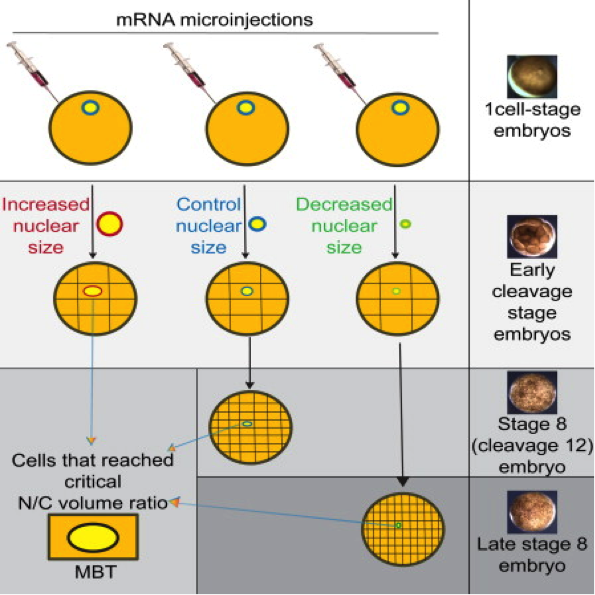Size matters: the bigger the nucleus, the sooner transcription begins
Timing of zygotic gene transcription and MBT determined by relative volume of nucleus and cytoplasm.
In an elegant set of experiments that manipulated the size of a nucleus and thus the Nucleus-to-Cytoplasm(N/C) volume ratio during early development, Predrag Jevtic and Daniel Levy from the University of Wyoming, studied the timing of zygotic gene transcription and the onset of the mid-blastula transition (MBT).
They demonstrate that “increasing the N/C volume ratio in pre-MBT embryos leads to premature activation of zygotic gene transcription and early onset of longer cell cycles. Conversely, decreasing the N/C volume ratio delays zygotic transcription and leads to additional rapid cell divisions.”
Highlights
•The N/C volume ratio increases prior to the MBT during Xenopus development
•Nuclear size and the N/C volume ratio can be manipulated in Xenopus embryos
•Altering the N/C volume ratio changes the timing of zygotic gene transcription
•Altering the N/C volume ratio changes the timing of cellular hallmarks of the MBT
Abstract
Early Xenopus laevis embryogenesis is a robust system for investigating mechanisms of developmental timing. After a series of rapid cell divisions with concomitant reductions in cell size, the first major developmental transition is the midblastula transition (MBT), when zygotic transcription begins and cell cycles elongate. Whereas the maintenance of a constant nuclear-to-cytoplasmic (N/C) volume ratio is a conserved cellular property, it has long been recognized that the N/C volume ratio changes dramatically during early Xenopus development. We investigated how changes in nuclear size and the N/C volume ratio during early development contribute to the regulation of MBT timing. Whereas previous studies suggested a role for the N/C volume ratio in MBT timing, none directly tested the effects of altering nuclear size. In this study, we first quantify blastomere and nuclear sizes in X. laevis embryos, demonstrating that the N/C volume ratio increases prior to the MBT. We then manipulate nuclear volume in embryos by microinjecting different nuclear scaling factors, including import proteins, lamins, and reticulons. Using this approach, we show that increasing the N/C volume ratio in pre-MBT embryos leads to premature activation of zygotic gene transcription and early onset of longer cell cycles. Conversely, decreasing the N/C volume ratio delays zygotic transcription and leads to additional rapid cell divisions. Whereas the DNA-to-cytoplasmic ratio has been implicated in MBT timing, our data show that nuclear size also contributes to the regulation of MBT timing, demonstrating the functional significance of nuclear size during development.

Reference:
Jevtic P and Levy DL. 2015 ‘Nuclear Size Scaling during Xenopus Early Development Contributes to Midblastula Transition Timing.’ Current Biology. 5;25(1):45-52. doi: 10.1016/j.cub.2014.10.051.
Click here to view the article on Xenbase.
Click here to view David Levy's page on Xenbase.
Click here to view the article on Pubmed.
Last Updated: 2015-03-04